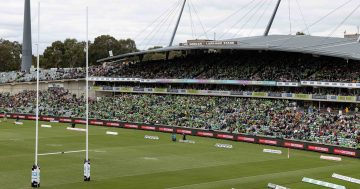
Sport, like the arts, is part of the culture of a place, Tim Gavel argues. File photo.
Why is it in Canberra every time ACT Government money is spent on elite sport or sporting facilities there is somewhat of a backlash?
I am writing this column in the wake of a campaign against any proposal to spend government funds on a new indoor stadium in Civic to cater for the Raiders, Brumbies and an A League team and other teams, in the future.
Some of the public comments suggested money would be better spent on health, education, the arts and roads. This is not a new response to sports funding. We have been through this in the past with spending on the upgrade of Canberra Stadium for the Olympics in 2000, the V8 Super Cars, GWS, the Raiders and the Brumbies.
Most professional clubs run at a loss and at best break even. Yet there is a perception that government funding is not justified. In most instances the government funding helps clubs break even.
That perception isn’t confined to the Raiders and the Brumbies with questions raised about using government funds to attract top level men’s and women’s cricket to the ACT or the Illawarra Hawks NBL side.
Many studies have shown the benefits of having major sporting events in Canberra. The most obvious benefit is that it improves the quality of life in the ACT for many wanting to see major events in their home city without having to travel. Sporting events also attract people to the city. Canberra offers a great alternative to many who might not want to navigate the traffic of Sydney, Melbourne, or even Brisbane. Sport can also generate business.
The growth in sports-based tourism businesses can’t be underestimated. We have experienced it first-hand with the considerable number of people coming to Canberra to watch the Raiders, Brumbies, GWS, the Socceroos, the Matildas, the Big Bash and international cricket.
There are also the aspirational and inspirational qualities associated with watching sport ‘live’ at the top level, inspiring some and entertaining others.
And sport, like the arts, is part of the culture of a place. It builds on our experiences and can bring enjoyment, pride and a host of other emotions. It can help bring about a ‘sense of place.’
Watching some of the young local athletes in numerous sports reach their goal, is incredibly fulfilling; particularly if you’ve seen them as tiny kids chasing a ball around on a chilly morning, to emerging as young highly proficient sports people. And watching them play their chosen sport at the highest level at home really does bring a sense of pride.
Then there is the flow-on influence of having major sporting teams and events in the ACT with every major sporting team funding junior development programs. This, in turn, improves the health of the next generation as they actively engage in a sport that has a recognisable pathway from juniors to elite. Along the way, recreational opportunities grow, keeping more people in a sport for longer. The social benefits, as well as the health benefits, are difficult to calculate.
Apart from the new indoor stadium, the priorities for sport include a new ice sports facility and a smaller multi-sport facility catering for events, not just sport, with a seating capacity of around 3,000.
Let the debate continue!




















